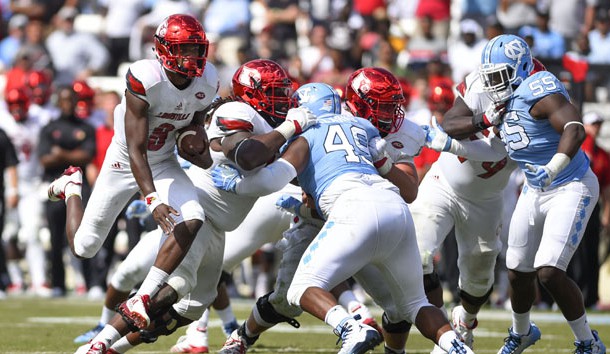
Sep 9, 2017; Chapel Hill, NC, USA; Louisville Cardinals quarterback Lamar Jackson (8) runs for a touchdown as North Carolina Tar Heels defensive tackle Jeremiah Clarke (49) and North Carolina Tar Heels defensive lineman Jason Strowbridge (55) defend in the fourth quarter. The Cardinals defeated the Tar Heels 47-35 at Kenan Memorial Stadium. Photo Credit: Bob Donnan-USA TODAY Sports
by Dane Brugler
The annual NFL Scouting Combine puts prospects through a grueling job interview process that tests them physical and mentally. The combine can basically be broken down into four categories: medical evaluations, interview process, agility/positional drills and verified measurements.
The sexiest aspect of the Combine: the athletic testing.
The 40-yard dash, vertical, broad jump, bench press and a few other drills allow NFL teams to match quantitative data with a player’s tape. The drills help provide context with each prospect participating on the same field, in the same setting and under the same circumstances (unlike campus pro days where scouts have to adjust for tracks, grass, wind, weather and several other factors).
Some label the Combine as nothing more than the “Underwear Olympics,” but longtime NFL scout C.O. Brocato, who was one of my mentors, once told me: “Those who don’t value the Combine, don’t know how to properly use it.”
This year, 326 invited prospects will travel to Indianapolis for the Combine, to be held February 27 to March 5. The athletic tests will be especially important for the following players:
Lamar Jackson, QB, Louisville
Everyone knows Jackson is an elite athlete, and his landing spot on draft day will depend on a team’s comfort with his development as a passer. However, putting up silly numbers in the athletic testing won’t hurt his chances.
Royce Freeman, RB, Oregon
Freeman was never the fastest or most explosive running back, but he appeared to lose a step following his injuries last season as a junior. Matching numbers to his athleticism will be interesting for evaluators.
Nyheim Hines, RB, N.C. State
A track standout in high school and at N.C. State, Hines was the state runner-up as a senior in high school in the 100 meters and 300-meter hurdles. He earned All-American honors as the Wolfpack’s leadoff leg for the 4×100-meter relay.
Malik Jefferson, LB, Texas
While there are questions about his instincts and overaggressive play, Jefferson is a top-tier athlete who should shine at the Combine. His explosiveness and athletic reflexes will be fun to watch.
Christian Kirk, WR, Texas A&M
With his athleticism out of the slot, NFL scouts are expecting above-average results from Kirk not only in the 40-yard dash, but also in the quick change-of-direction drills. His numbers could be the difference in going first round or not.
Courtland Sutton, WR, SMU
Sutton faces a large jump from what he was asked to do in SMU’s offense compared to the NFL. His routes lack refinement, and scouts are eager to put a number on his speed — is he a 4.52 athlete? Or more like 4.58?
James Washington, WR, Oklahoma State
Washington victimized Big 12 cornerbacks, which also makes it tough to gauge his speed. He is one of the better vertical threats in the class, but does he have 4.35 speed? Or 4.55 speed? That will be an important distinction for scouts.
DJ Chark, WR, LSU
This year’s Will Fuller? Chark had an up-and-down LSU career, but his ability to stretch the defense with speed and sudden feet should translate to big numbers at the Combine. Fuller ran a 4.31 and vaulted into the first round; it wouldn’t be a surprise if Chark had a similar ascension.
DaeSean Hamilton, WR, Penn State
One of the top-three route runners in this draft class, Hamilton needs to build upon the momentum he started at the Senior Bowl. He isn’t expected to run a 4.3, but some scouts are worried his athletic testing will be below average.
Korey Robertson, WR, Southern Miss
A large-framed athlete, Robertson has more build-up speed than instant acceleration, so scouts will be paying close attention to his 10-yard split and his time between 20-40 yards compared to the other receivers who are 6-foot-1 are taller.
Troy Fumagalli, TE, Wisconsin
Fumagalli is able to be productive with his route-running and ball skills, but he isn’t a dynamic athlete and lacks an explosive gear. How will his numbers match up with the other talented tight ends in this stacked group?
Orlando Brown, OT, Oklahoma
A massive, plodding blocker, Brown’s game is built more on power than quickness, which works for him with his large base and humongous wingspan. He isn’t expected to blow anyone away in drills, but he can’t be deficient in them either.
Brian O’Neill, OT, Pittsburgh
A former tight end, O’Neill isn’t a power player — and that is the main issue with his NFL projection. For him to maximize his draft potential, he needs to turn heads with his athletic testing.
Greg Senat, OT, Wagner
Hailing from FCS-level Wagner, Senat is a basketball-to-football convert with minimal experience on the football field. But as a former hard-court standout, he should perform well with his athletic testing, which will be something evaluators can point to when debating where he fits on the draft board.
Hercules Mata’afa, DE/OLB, Washington State
One of the biggest wildcard prospects in this class, Mata’afa was dominant as an interior pass rusher last season, but at 250-ish pounds, he will transition to an edge or linebacker position in the NFL. How he tests and performs in drills will be critical to his evaluation.
Kemoko Turay, DE/OLB, Rutgers
A former basketball and track standout in high school, Turay runs like the wind and should light up the stopwatches at 250 pounds. His draft arrow continues to point north after a strong Senior Bowl week.
Josh Sweat, DE/OLB, Florida State
While the medicals are the most important part of his Combine, Sweat should also be a workout warrior with his movement skills and pure speed.
Vita Vea, DT, Washington
There will be no bathroom breaks by scouts or coaches when it is Vea’s turn on the field at Lucas Oil Stadium. NFL evaluators are eager to see the show, with many expecting Vea to run a sub-5.00 40-yard dash at 340-plus pounds — just like Dontari Poe in 2012.
Taven Bryan, DT, Florida
Bryan was considered one of the most athletic players on the Florida roster, not just the defensive line. His game is very streaky; positive numbers in the agility and movement drills will help dissipate some of the doubt.
Nathan Shepherd, DT, Fort Hays State
A nimble big man, Shepherd impressed in Mobile, but that might have just been the opening act. At 6-4 and 310 pounds, he should prove to be one of the more athletic defensive linemen in Indianapolis this year.
Josey Jewell, LB, Iowa
Although he isn’t a poor athlete, Jewell has some limitations laterally, showing clear stiffness on tape. It will be interesting to compare his workout numbers with the other linebacker prospects in this class.
Lorenzo Carter, LB, Georgia
A former basketball star in high school, Carter has twitchy muscles to easily redirect and run. His greasy joints and range are something to watch on the football field, and scouts are expecting him to crush the agility drills.
Denzel Ward, CB, Ohio State
Any conversation about the fastest player in the 2018 NFL Draft must include Ward, who won the 2015 Ohio state high school title in the 200 meters (21.65). Scouts are expecting a sub 4.35 40-yard dash from the Buckeyes cornerback.
Isaiah Oliver, CB, Colorado
An accomplished decathlete in high school and at Colorado, Oliver won the high school state championship in the hurdles, but he doesn’t play with elite speed.
Donte Jackson, CB, LSU
My pick for the fastest 40-yard dash at this year’s Combine, Jackson has blur speed and might register in the 4.2’s in the 40. He won numerous accolades as a track athlete in high school and also ran track at LSU, registering a personal-best 10.22 in the 100 meters at the SEC relays.
Quenton Meeks, CB, Stanford
There is a lot to like about Meeks’ tape with his size, length and intelligence. However, he isn’t a twitchy athlete and long-speed is a concern. His 40-yard dash will carry plenty of significance for scouts.
Tony Brown, CB, Alabama
A standout in football and track at Alabama, Brown has silly speed, becoming the school’s first All-American in the 110-hurdles since 2002, also setting a personal best in the 100 meters (10.27). His football career in Tuscaloosa didn’t go quite as planned, but you can’t teach that type of speed.
Derwin James, S, Florida State
They might rename the Combine after James once he’s done.
DeShone Elliott, S, Texas
With nine career interceptions, including six in 2017, some assume Elliott is an athletic ball-hawk with plus range. However, the tape tells a different story, including stiff hips and long-speed questions.


